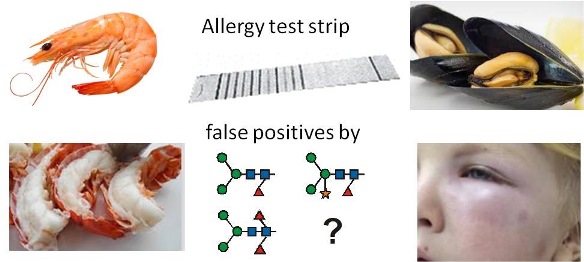Exact structures of cross-reactive carbohydrate determinants of insect and seafood allergens
SUPERVISOR: FRIEDRICH ALTMANN
Background.
A majority of allergens comes from species belonging to either the plant kingdom or the phylum of arthropodes (notably insects and crustaceans and within these members of the orders hymenoptera and decapods). A serious commonality between these phylogenetically distinct organisms is the occurrence of fucose in a1,3-linkage to the Asn-linked GlcNAc residue in N-glycosylated proteins (Altmann, 2007). About a quarter of all allergic patients develop IgE antibodies not only against the protein part of allergen components but also against the carbohydrate moiety. These N-glycans, however, essentially show identity within all plant species and still high similarity between plants and insects (Tretter et al., 1993). As a consequence, antibodies raised against any such glycoprotein cross-react with any other plant or insect glycoprotein - hence the name cross-reactive carbohydrate determinants (CCDs) (van der Veen et al., 1997). At first – i.e. about 20 years ago – researchers expected manifest allergic reactions but soon it became evident that these N-glycans were clinically irrelevant (van der Veen et al., 1997; Mari et al., 2008; Holzweber et al., 2013). This realization, however, has consequences with regard to the assessment of positive serum IgE results of patients with anti-CCD IgE, which then are obviously false-positive.

The idea of elimination the CCD problem by way of recombinant allergens hit the wall of a) high costs of e.g. the ImmunoCAP ISAC microarray and b) the necessity for use of several natural glycoprotein components. Therefore an assay-platform independent approach was developed in the form a semi-arteficial CCD-inhibitor (Holzweber et al., 2013).
This polyvalent inhibitor contains glycopeptides from pineapple bromelain and abolishes CCD-based reactions in > 95% of CCD-sensitized patients. It is now distributed to customers all over Europe and beyond. However, sporadic problems occur with inhibitions of reactions towards insect venoms. Insect stings cause numerous fatalities every year. The resulting inclination for allergen-specific immune therapy asks for a correct choice of allergen for this treatment. To this end, the optimal CCD inhibitor structure for insect venoms should be identified. In addition, the glycan structures of the phylogenetically related crustaceans have, to the applicant’s knowledge, not been studied thoroughly and certainly not in the light of allergy diagnosis.
Aims and methods.
The first part of this project will provide a set of possible target structures for anti-CCD IgE from insect venom-sensitized patients. The currently used CCD reagent derived from bromelain contains the MUXF3 structure, i.e. a glycan with xylose and 3-fucose where the a1,3-mannose is missing. This structure is linked to a very small peptide moiety allowing its chemical attachment to protein or surfaces. For this project, similar glycopeptides with i) the a1,3-mannose in place, without xylose and with a1,3-fucose (MMF3) and the typical hyaluronidase structure with an additional a1,6-fucose (MMF3F6) shall be generated using scaffold N-glycopeptides from e.g. bovine fibrin and recombinant fucosyltransferases as no handy natural source for such structures exists.
In the second part of the work the interaction of these probes with patients´ IgE and IgG will be investigated. Sera of patients with a relevant history (i.a. bee keepers) will be obtained through our well established cooperation with the FAZ-Floridsdorf Allergy Center (Dr. Wolfgang Hemmer). ELISA and ELISA inhibition work will be performed with both IgE and IgG. The latter will also be used to compare binding affinities via surface plasmon resonance.
In parallel to these activities, carbohydrate based IgE interaction with extracts from crustaceans (lobster and crayfish on the one hand and prawns and shrimps on the other) will be examined. Again, relevant sera will be obtained from the FAZ and reacted with glycopeptides from the seafood samples. The structures of their N-glycans will be established with special focus on core a1,3-fucose.
Collaborations within this thesis will include MACH and GRABHERR (baculovirus/insect cell expression), OBINGER (Surface plasmon resonance) and OOSTENBRINK (molecular modeling).
Altmann, F. (2007) The role of protein glycosylation in allergy. Int. Arch. Allergy Immunol. 142, 99-115. doi: 10.1159/000096114
Holzweber, F., Svehla, E., Fellner, W., Dalik, T., Stubler, S., Hemmer, W., Altmann, F. (2013) Inhibition of IgE binding to cross-reactive carbohydrate determinants enhances diagnostic selectivity. Allergy 68, 1269-1277. doi: 10.1111/all.12229
Mari, A., Ooievaar-de Heer, P., Scala, E., Giani, M., Pirrotta, L., Zuidmeer, L., Bethell, van Ree, R. (2008) Evaluation by double-blind placebo-controlled oral challenge of the clinical relevance of IgE antibodies against plant glycans. Allergy 63, 891-896. doi:10.1111/j.1398-9995.2008.01703.x
Tretter, V., Altmann, F., Kubelka, V., Marz, L., Becker, W.M. (1993) Fucose alpha 1,3-linked to the core region of glycoprotein N-glycans creates an important epitope for IgE from honeybee venom allergic individuals. Int. Arch. Allergy Immunol. 102, 259-266. doi:10.1159/000236534
van der Veen, M.J., van Ree, R., Aalberse, R.C., Akkerdaas, J., Koppelman, S.J., Jansen, H.M., van der Zee, J. S. (1997) Poor biologic activity of cross-reactive IgE directed to carbohydrate determinants of glycoproteins. J. Allergy Clin. Immunol. 100, 327-334. doi: 10.1016/S0091-6749(97)70245-8
